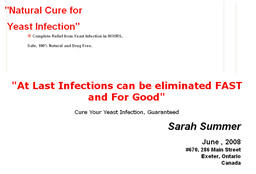Yeast Infection Home remedy number one...
Probably the most well-known and safest yeast infection remedy is the use of Boric Acid. Boric Acid has natural antifungal and antiviral properties. It works by helping to restore the proper acidic pH in the vagina. This makes it unfriendly to the yeasts. You can by Boric Acid at your local pharmacy. Boric acid as a yeast infection home cure can be used in a couple different ways. You can use it in a sitz bath or you can use it as a vaginal suppository. One use you should never try is ingesting it. Boric Acid is toxic and you may do serious harm to your body by drinking it. I can't imagine why anyone would, but I'm sure it happens every now and again.
Here's how to do a Boric Acid Sitz Bath...
(Note: A "sitz" bath is a type of bath where only the hips and buttocks are soaked in water or saline solution.)
- Fill a sitz bath with warm water,
- Dissolve two teaspoons of Boric Acid in a cup of boiling water,
- Dump the mixture in the bath.
- Add about 1/3 cup of witch hazel.
- Sit for 10-15 minutes.
- Repeat this process for about a week (or until the infection is gone).
Here how you can make a "sitz" bath in your regular bathtub...
- Fill the your bath tub with slightly hot water about 2 inches deep.
- Dissolve 1/2 cup of Boric Acid in boiling water
- Pour the Boric Acid mixture into the water.
- Sit for 10-15 minutes every night until the yeast infection is gone (this could take about a week
Yeast Infection Home Remedy number 2
Boric Acid Vaginal Suppositories
A very effective way of treating vaginal yeast infection is using a Boric Acid Suppository. You can either buy one (Amazon carries them) or you can make your own by filling the powder into a capsule:
- Buy Boric Acid powder in the pharmacy.
- Buy size 00 gelatin capsules in a drugstore (drugstore.com online).
- Fill some Boric Acid powder into two size 00 gelatin capsules.
- Insert one or two capsules with your clean fingers as far up as you can into the vagina.
- Use it straight every night for a full week, then stagger it every other night. After about a week of that, stagger it every two nights.
Whenever you feel that you may have a yeast infection coming on, put a capsule in for 3-4 nights. To prevent a recurrent yeast infection Boric Acid Vaginal Suppository can be used twice a week for 6 months.
IMPORTANT: DO NOT use the vaginal Boric Acid treatment if you are pregnant!
More Natural cures for yeast infections coming tomorrow.
Here's a proven natural cure for yeast infections that you may want to take a look at.
